Organisational Behaviour Report: 4com Plc Analysis and Recommendations
VerifiedAdded on 2020/11/23
|17
|5516
|346
Report
AI Summary
This report provides a comprehensive analysis of organisational behaviour, focusing on key concepts such as culture, power dynamics, and organizational politics within the context of 4com Plc, a telecommunications SME. The report examines the influence of culture on individual and team performance, exploring models like Handy's and Hofstede's to understand different organizational cultures. It also delves into the impact of power, utilizing French and Raven's power model to analyze various forms of power within the organization. Furthermore, the report investigates the role of politics in shaping organizational dynamics. The second part of the report explores content and process theories of motivation, specifically examining Maslow's hierarchy of needs and Herzberg's two-factor theory to understand how 4com Plc can motivate its employees. The report also differentiates between effective and ineffective teams and discusses the concepts and philosophies of organisational behaviour. The report concludes with recommendations for improving organizational effectiveness and employee satisfaction.
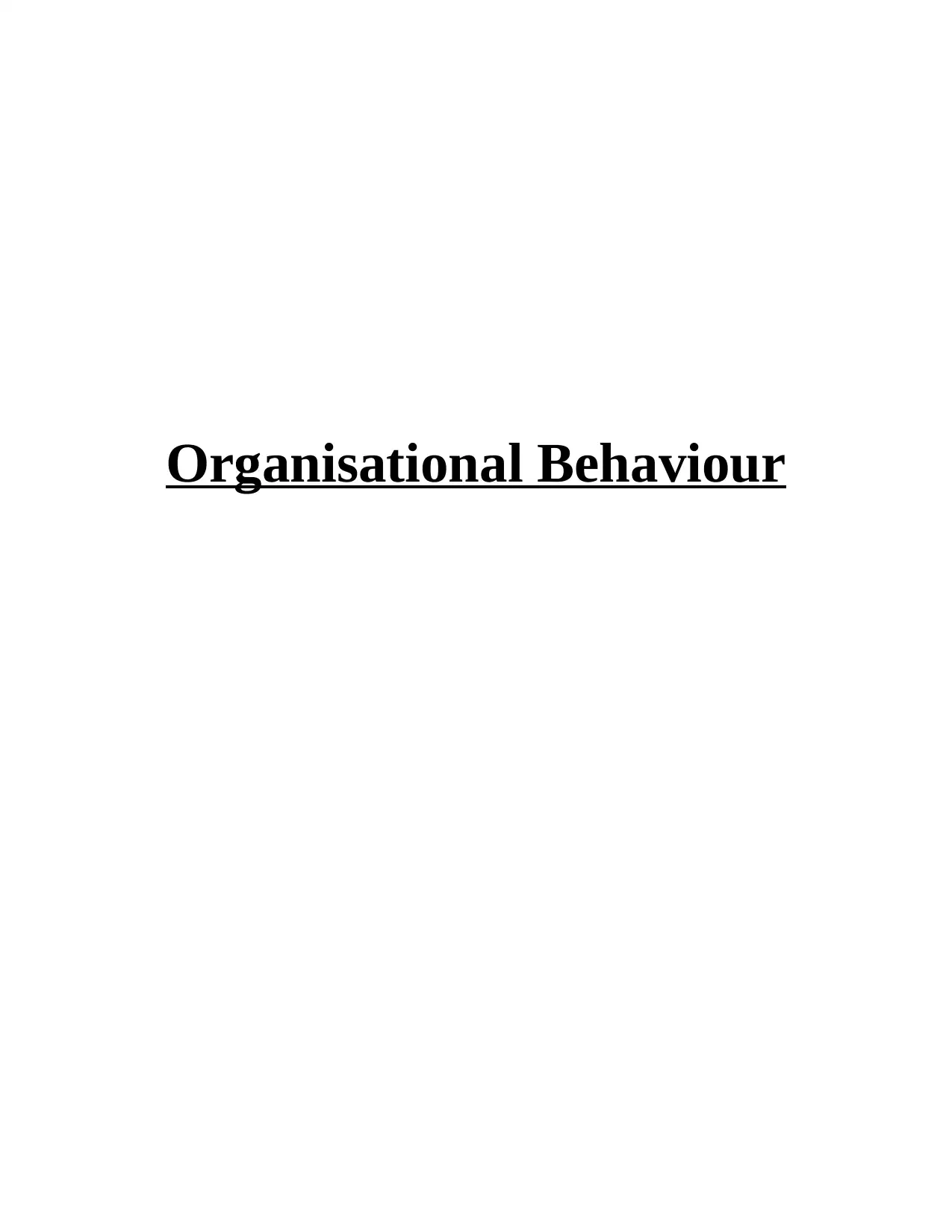
Organisational Behaviour
Paraphrase This Document
Need a fresh take? Get an instant paraphrase of this document with our AI Paraphraser
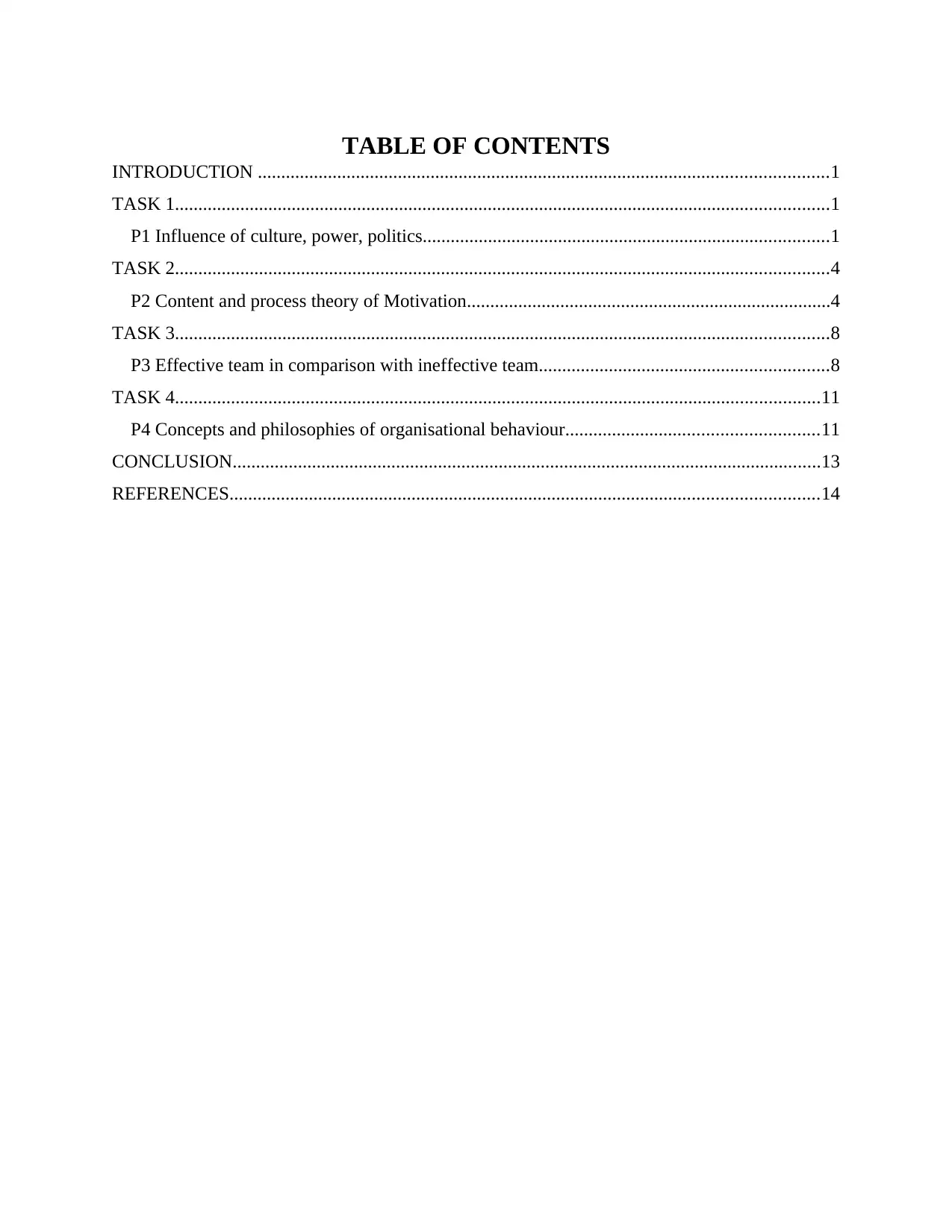
TABLE OF CONTENTS
INTRODUCTION ..........................................................................................................................1
TASK 1............................................................................................................................................1
P1 Influence of culture, power, politics.......................................................................................1
TASK 2............................................................................................................................................4
P2 Content and process theory of Motivation..............................................................................4
TASK 3............................................................................................................................................8
P3 Effective team in comparison with ineffective team..............................................................8
TASK 4..........................................................................................................................................11
P4 Concepts and philosophies of organisational behaviour......................................................11
CONCLUSION..............................................................................................................................13
REFERENCES..............................................................................................................................14
INTRODUCTION ..........................................................................................................................1
TASK 1............................................................................................................................................1
P1 Influence of culture, power, politics.......................................................................................1
TASK 2............................................................................................................................................4
P2 Content and process theory of Motivation..............................................................................4
TASK 3............................................................................................................................................8
P3 Effective team in comparison with ineffective team..............................................................8
TASK 4..........................................................................................................................................11
P4 Concepts and philosophies of organisational behaviour......................................................11
CONCLUSION..............................................................................................................................13
REFERENCES..............................................................................................................................14
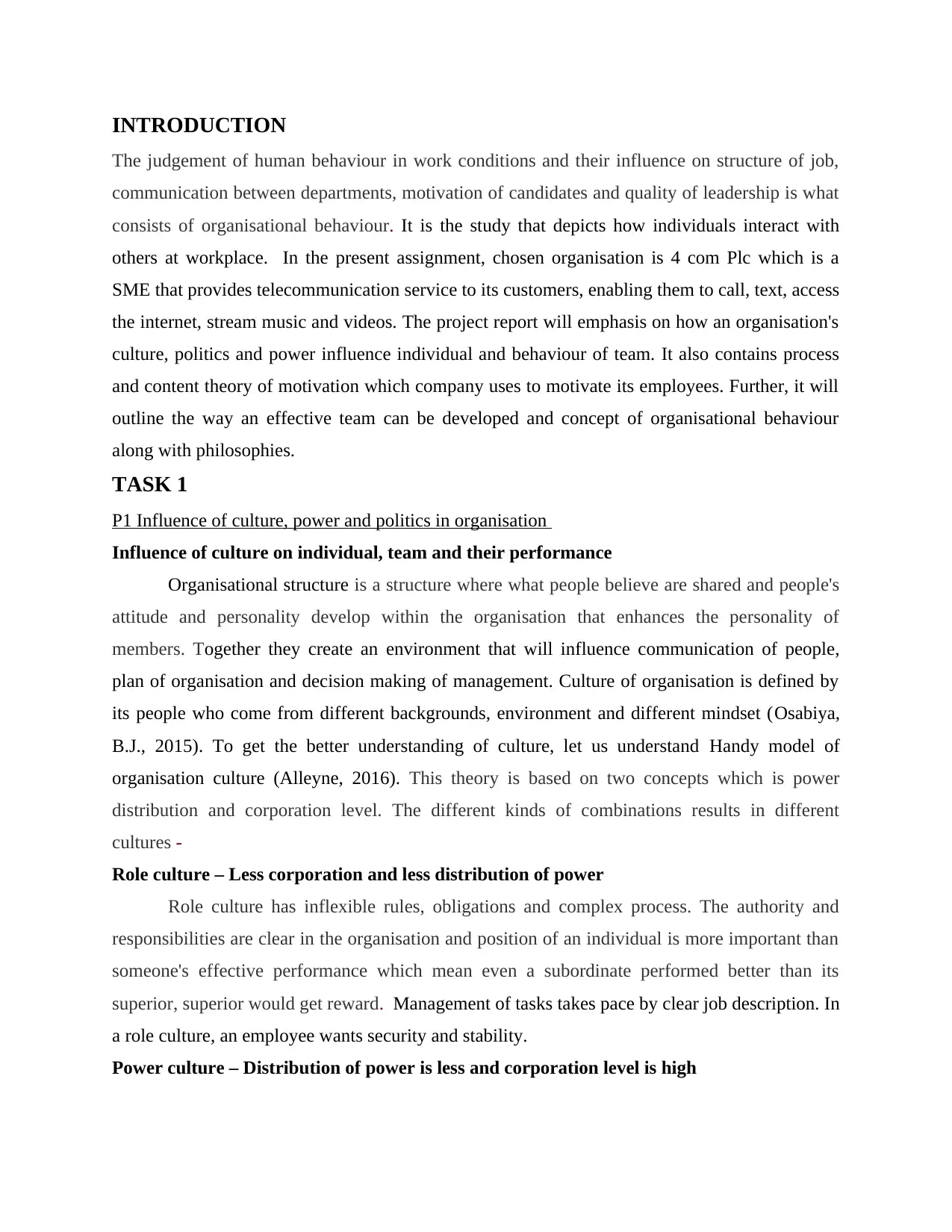
INTRODUCTION
The judgement of human behaviour in work conditions and their influence on structure of job,
communication between departments, motivation of candidates and quality of leadership is what
consists of organisational behaviour. It is the study that depicts how individuals interact with
others at workplace. In the present assignment, chosen organisation is 4 com Plc which is a
SME that provides telecommunication service to its customers, enabling them to call, text, access
the internet, stream music and videos. The project report will emphasis on how an organisation's
culture, politics and power influence individual and behaviour of team. It also contains process
and content theory of motivation which company uses to motivate its employees. Further, it will
outline the way an effective team can be developed and concept of organisational behaviour
along with philosophies.
TASK 1
P1 Influence of culture, power and politics in organisation
Influence of culture on individual, team and their performance
Organisational structure is a structure where what people believe are shared and people's
attitude and personality develop within the organisation that enhances the personality of
members. Together they create an environment that will influence communication of people,
plan of organisation and decision making of management. Culture of organisation is defined by
its people who come from different backgrounds, environment and different mindset (Osabiya,
B.J., 2015). To get the better understanding of culture, let us understand Handy model of
organisation culture (Alleyne, 2016). This theory is based on two concepts which is power
distribution and corporation level. The different kinds of combinations results in different
cultures -
Role culture – Less corporation and less distribution of power
Role culture has inflexible rules, obligations and complex process. The authority and
responsibilities are clear in the organisation and position of an individual is more important than
someone's effective performance which mean even a subordinate performed better than its
superior, superior would get reward. Management of tasks takes pace by clear job description. In
a role culture, an employee wants security and stability.
Power culture – Distribution of power is less and corporation level is high
The judgement of human behaviour in work conditions and their influence on structure of job,
communication between departments, motivation of candidates and quality of leadership is what
consists of organisational behaviour. It is the study that depicts how individuals interact with
others at workplace. In the present assignment, chosen organisation is 4 com Plc which is a
SME that provides telecommunication service to its customers, enabling them to call, text, access
the internet, stream music and videos. The project report will emphasis on how an organisation's
culture, politics and power influence individual and behaviour of team. It also contains process
and content theory of motivation which company uses to motivate its employees. Further, it will
outline the way an effective team can be developed and concept of organisational behaviour
along with philosophies.
TASK 1
P1 Influence of culture, power and politics in organisation
Influence of culture on individual, team and their performance
Organisational structure is a structure where what people believe are shared and people's
attitude and personality develop within the organisation that enhances the personality of
members. Together they create an environment that will influence communication of people,
plan of organisation and decision making of management. Culture of organisation is defined by
its people who come from different backgrounds, environment and different mindset (Osabiya,
B.J., 2015). To get the better understanding of culture, let us understand Handy model of
organisation culture (Alleyne, 2016). This theory is based on two concepts which is power
distribution and corporation level. The different kinds of combinations results in different
cultures -
Role culture – Less corporation and less distribution of power
Role culture has inflexible rules, obligations and complex process. The authority and
responsibilities are clear in the organisation and position of an individual is more important than
someone's effective performance which mean even a subordinate performed better than its
superior, superior would get reward. Management of tasks takes pace by clear job description. In
a role culture, an employee wants security and stability.
Power culture – Distribution of power is less and corporation level is high
⊘ This is a preview!⊘
Do you want full access?
Subscribe today to unlock all pages.

Trusted by 1+ million students worldwide
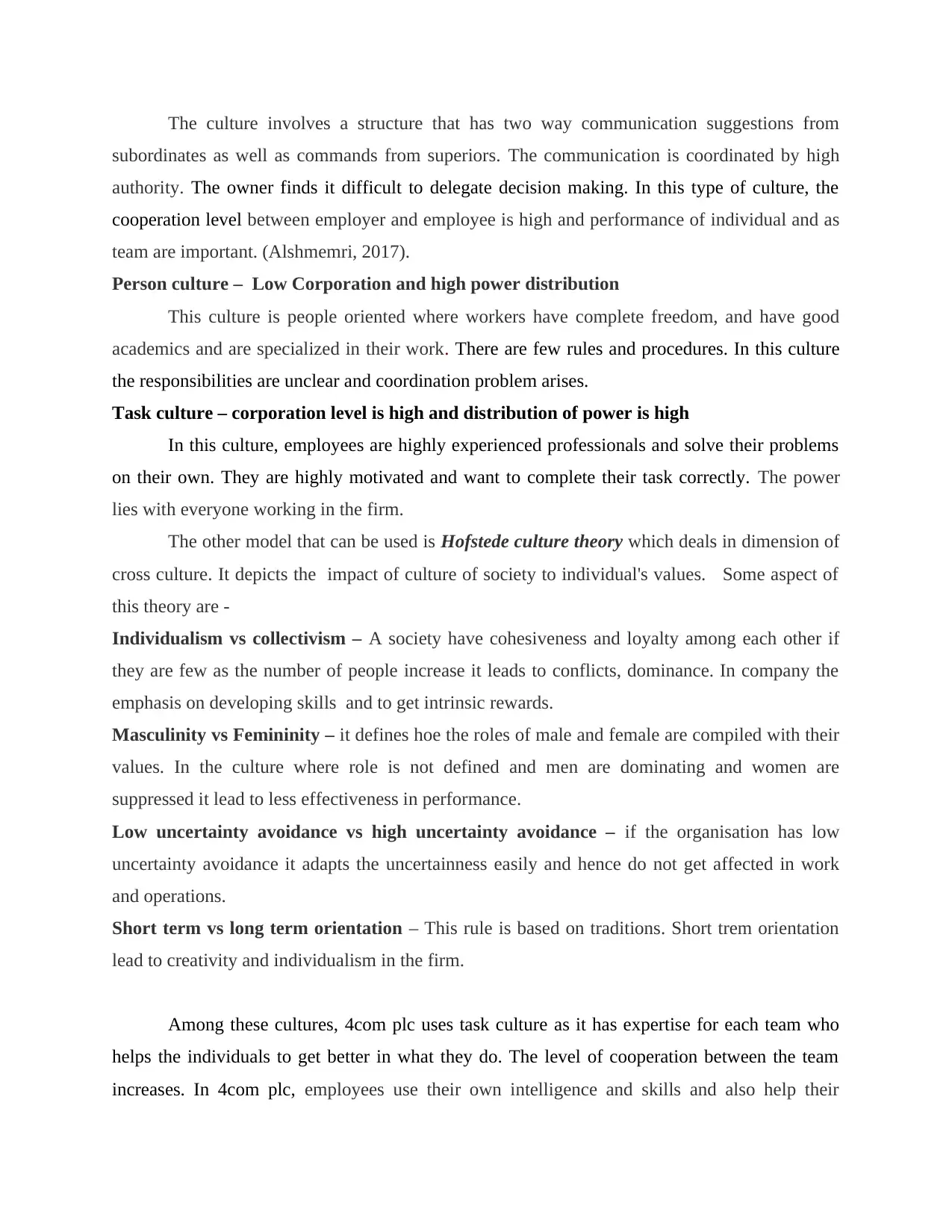
The culture involves a structure that has two way communication suggestions from
subordinates as well as commands from superiors. The communication is coordinated by high
authority. The owner finds it difficult to delegate decision making. In this type of culture, the
cooperation level between employer and employee is high and performance of individual and as
team are important. (Alshmemri, 2017).
Person culture – Low Corporation and high power distribution
This culture is people oriented where workers have complete freedom, and have good
academics and are specialized in their work. There are few rules and procedures. In this culture
the responsibilities are unclear and coordination problem arises.
Task culture – corporation level is high and distribution of power is high
In this culture, employees are highly experienced professionals and solve their problems
on their own. They are highly motivated and want to complete their task correctly. The power
lies with everyone working in the firm.
The other model that can be used is Hofstede culture theory which deals in dimension of
cross culture. It depicts the impact of culture of society to individual's values. Some aspect of
this theory are -
Individualism vs collectivism – A society have cohesiveness and loyalty among each other if
they are few as the number of people increase it leads to conflicts, dominance. In company the
emphasis on developing skills and to get intrinsic rewards.
Masculinity vs Femininity – it defines hoe the roles of male and female are compiled with their
values. In the culture where role is not defined and men are dominating and women are
suppressed it lead to less effectiveness in performance.
Low uncertainty avoidance vs high uncertainty avoidance – if the organisation has low
uncertainty avoidance it adapts the uncertainness easily and hence do not get affected in work
and operations.
Short term vs long term orientation – This rule is based on traditions. Short trem orientation
lead to creativity and individualism in the firm.
Among these cultures, 4com plc uses task culture as it has expertise for each team who
helps the individuals to get better in what they do. The level of cooperation between the team
increases. In 4com plc, employees use their own intelligence and skills and also help their
subordinates as well as commands from superiors. The communication is coordinated by high
authority. The owner finds it difficult to delegate decision making. In this type of culture, the
cooperation level between employer and employee is high and performance of individual and as
team are important. (Alshmemri, 2017).
Person culture – Low Corporation and high power distribution
This culture is people oriented where workers have complete freedom, and have good
academics and are specialized in their work. There are few rules and procedures. In this culture
the responsibilities are unclear and coordination problem arises.
Task culture – corporation level is high and distribution of power is high
In this culture, employees are highly experienced professionals and solve their problems
on their own. They are highly motivated and want to complete their task correctly. The power
lies with everyone working in the firm.
The other model that can be used is Hofstede culture theory which deals in dimension of
cross culture. It depicts the impact of culture of society to individual's values. Some aspect of
this theory are -
Individualism vs collectivism – A society have cohesiveness and loyalty among each other if
they are few as the number of people increase it leads to conflicts, dominance. In company the
emphasis on developing skills and to get intrinsic rewards.
Masculinity vs Femininity – it defines hoe the roles of male and female are compiled with their
values. In the culture where role is not defined and men are dominating and women are
suppressed it lead to less effectiveness in performance.
Low uncertainty avoidance vs high uncertainty avoidance – if the organisation has low
uncertainty avoidance it adapts the uncertainness easily and hence do not get affected in work
and operations.
Short term vs long term orientation – This rule is based on traditions. Short trem orientation
lead to creativity and individualism in the firm.
Among these cultures, 4com plc uses task culture as it has expertise for each team who
helps the individuals to get better in what they do. The level of cooperation between the team
increases. In 4com plc, employees use their own intelligence and skills and also help their
Paraphrase This Document
Need a fresh take? Get an instant paraphrase of this document with our AI Paraphraser
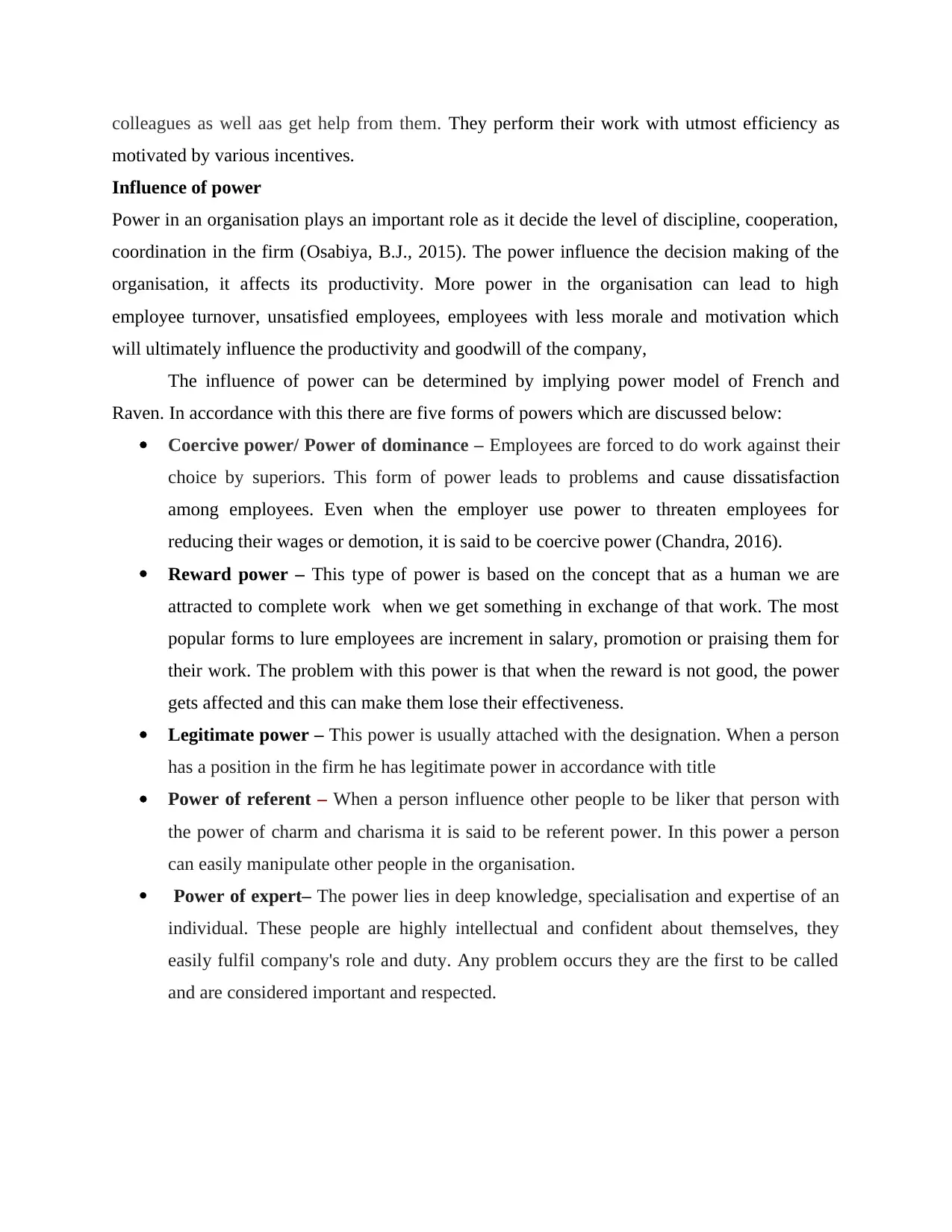
colleagues as well aas get help from them. They perform their work with utmost efficiency as
motivated by various incentives.
Influence of power
Power in an organisation plays an important role as it decide the level of discipline, cooperation,
coordination in the firm (Osabiya, B.J., 2015). The power influence the decision making of the
organisation, it affects its productivity. More power in the organisation can lead to high
employee turnover, unsatisfied employees, employees with less morale and motivation which
will ultimately influence the productivity and goodwill of the company,
The influence of power can be determined by implying power model of French and
Raven. In accordance with this there are five forms of powers which are discussed below:
Coercive power/ Power of dominance – Employees are forced to do work against their
choice by superiors. This form of power leads to problems and cause dissatisfaction
among employees. Even when the employer use power to threaten employees for
reducing their wages or demotion, it is said to be coercive power (Chandra, 2016).
Reward power – This type of power is based on the concept that as a human we are
attracted to complete work when we get something in exchange of that work. The most
popular forms to lure employees are increment in salary, promotion or praising them for
their work. The problem with this power is that when the reward is not good, the power
gets affected and this can make them lose their effectiveness.
Legitimate power – This power is usually attached with the designation. When a person
has a position in the firm he has legitimate power in accordance with title
Power of referent – When a person influence other people to be liker that person with
the power of charm and charisma it is said to be referent power. In this power a person
can easily manipulate other people in the organisation.
Power of expert– The power lies in deep knowledge, specialisation and expertise of an
individual. These people are highly intellectual and confident about themselves, they
easily fulfil company's role and duty. Any problem occurs they are the first to be called
and are considered important and respected.
motivated by various incentives.
Influence of power
Power in an organisation plays an important role as it decide the level of discipline, cooperation,
coordination in the firm (Osabiya, B.J., 2015). The power influence the decision making of the
organisation, it affects its productivity. More power in the organisation can lead to high
employee turnover, unsatisfied employees, employees with less morale and motivation which
will ultimately influence the productivity and goodwill of the company,
The influence of power can be determined by implying power model of French and
Raven. In accordance with this there are five forms of powers which are discussed below:
Coercive power/ Power of dominance – Employees are forced to do work against their
choice by superiors. This form of power leads to problems and cause dissatisfaction
among employees. Even when the employer use power to threaten employees for
reducing their wages or demotion, it is said to be coercive power (Chandra, 2016).
Reward power – This type of power is based on the concept that as a human we are
attracted to complete work when we get something in exchange of that work. The most
popular forms to lure employees are increment in salary, promotion or praising them for
their work. The problem with this power is that when the reward is not good, the power
gets affected and this can make them lose their effectiveness.
Legitimate power – This power is usually attached with the designation. When a person
has a position in the firm he has legitimate power in accordance with title
Power of referent – When a person influence other people to be liker that person with
the power of charm and charisma it is said to be referent power. In this power a person
can easily manipulate other people in the organisation.
Power of expert– The power lies in deep knowledge, specialisation and expertise of an
individual. These people are highly intellectual and confident about themselves, they
easily fulfil company's role and duty. Any problem occurs they are the first to be called
and are considered important and respected.
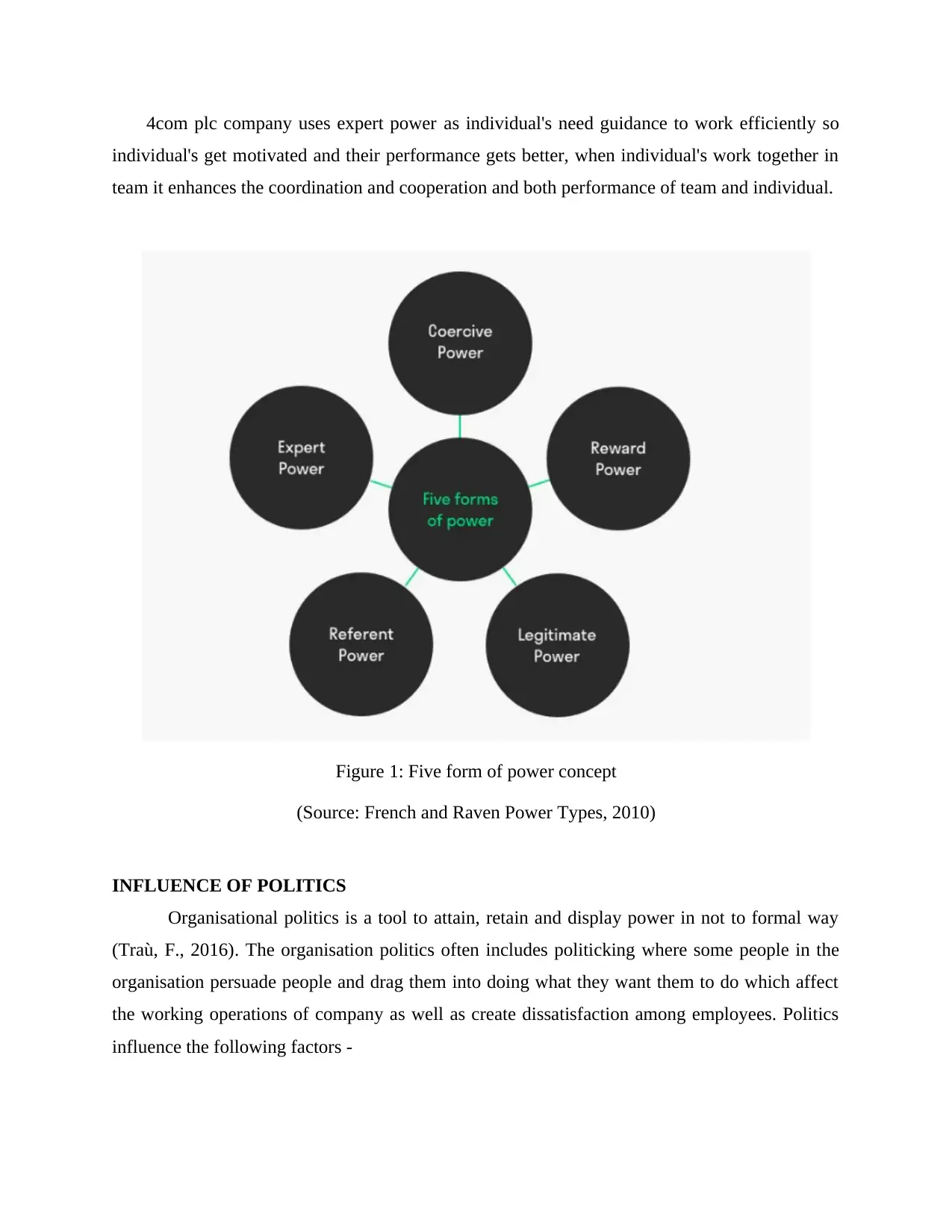
4com plc company uses expert power as individual's need guidance to work efficiently so
individual's get motivated and their performance gets better, when individual's work together in
team it enhances the coordination and cooperation and both performance of team and individual.
INFLUENCE OF POLITICS
Organisational politics is a tool to attain, retain and display power in not to formal way
(Traù, F., 2016). The organisation politics often includes politicking where some people in the
organisation persuade people and drag them into doing what they want them to do which affect
the working operations of company as well as create dissatisfaction among employees. Politics
influence the following factors -
Figure 1: Five form of power concept
(Source: French and Raven Power Types, 2010)
individual's get motivated and their performance gets better, when individual's work together in
team it enhances the coordination and cooperation and both performance of team and individual.
INFLUENCE OF POLITICS
Organisational politics is a tool to attain, retain and display power in not to formal way
(Traù, F., 2016). The organisation politics often includes politicking where some people in the
organisation persuade people and drag them into doing what they want them to do which affect
the working operations of company as well as create dissatisfaction among employees. Politics
influence the following factors -
Figure 1: Five form of power concept
(Source: French and Raven Power Types, 2010)
⊘ This is a preview!⊘
Do you want full access?
Subscribe today to unlock all pages.

Trusted by 1+ million students worldwide
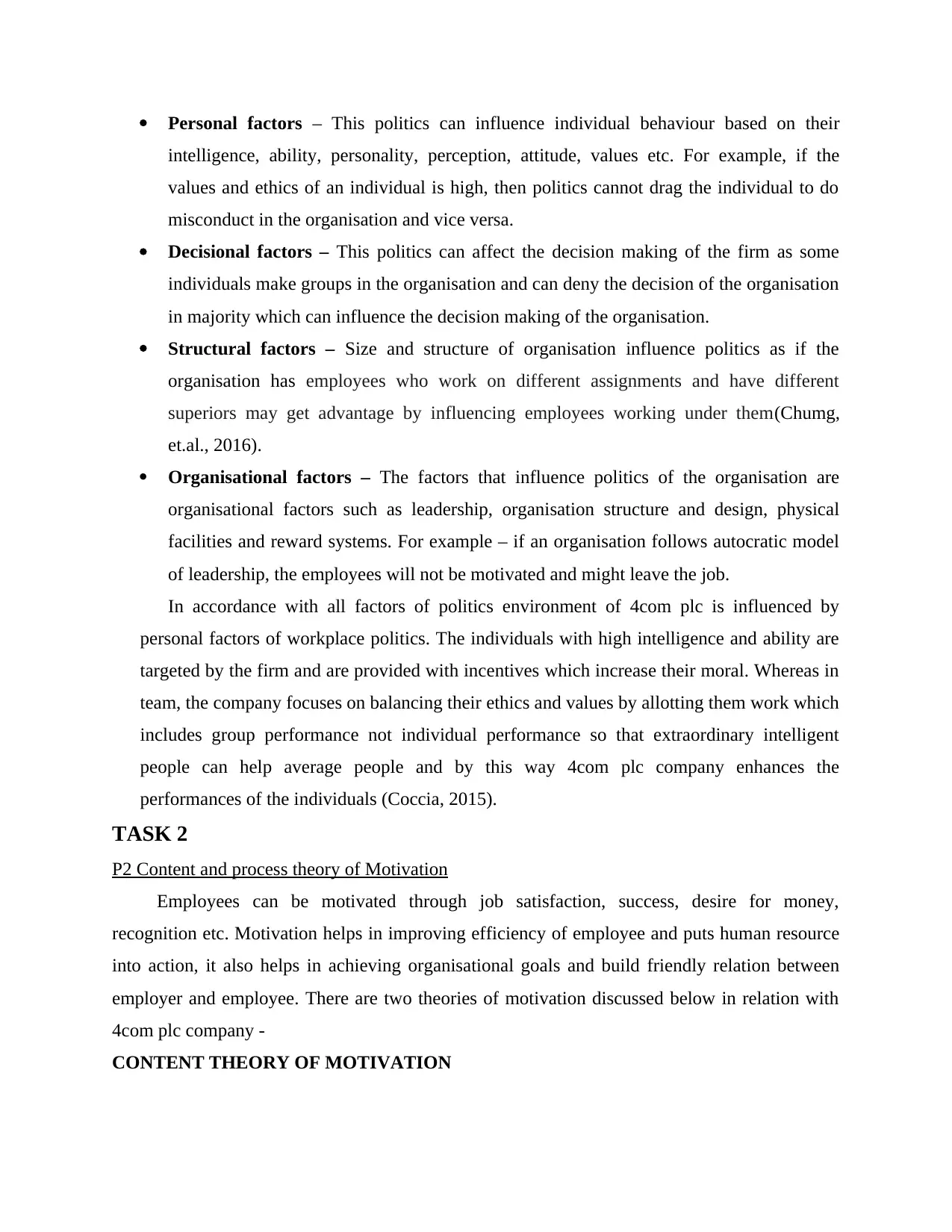
Personal factors – This politics can influence individual behaviour based on their
intelligence, ability, personality, perception, attitude, values etc. For example, if the
values and ethics of an individual is high, then politics cannot drag the individual to do
misconduct in the organisation and vice versa.
Decisional factors – This politics can affect the decision making of the firm as some
individuals make groups in the organisation and can deny the decision of the organisation
in majority which can influence the decision making of the organisation.
Structural factors – Size and structure of organisation influence politics as if the
organisation has employees who work on different assignments and have different
superiors may get advantage by influencing employees working under them(Chumg,
et.al., 2016).
Organisational factors – The factors that influence politics of the organisation are
organisational factors such as leadership, organisation structure and design, physical
facilities and reward systems. For example – if an organisation follows autocratic model
of leadership, the employees will not be motivated and might leave the job.
In accordance with all factors of politics environment of 4com plc is influenced by
personal factors of workplace politics. The individuals with high intelligence and ability are
targeted by the firm and are provided with incentives which increase their moral. Whereas in
team, the company focuses on balancing their ethics and values by allotting them work which
includes group performance not individual performance so that extraordinary intelligent
people can help average people and by this way 4com plc company enhances the
performances of the individuals (Coccia, 2015).
TASK 2
P2 Content and process theory of Motivation
Employees can be motivated through job satisfaction, success, desire for money,
recognition etc. Motivation helps in improving efficiency of employee and puts human resource
into action, it also helps in achieving organisational goals and build friendly relation between
employer and employee. There are two theories of motivation discussed below in relation with
4com plc company -
CONTENT THEORY OF MOTIVATION
intelligence, ability, personality, perception, attitude, values etc. For example, if the
values and ethics of an individual is high, then politics cannot drag the individual to do
misconduct in the organisation and vice versa.
Decisional factors – This politics can affect the decision making of the firm as some
individuals make groups in the organisation and can deny the decision of the organisation
in majority which can influence the decision making of the organisation.
Structural factors – Size and structure of organisation influence politics as if the
organisation has employees who work on different assignments and have different
superiors may get advantage by influencing employees working under them(Chumg,
et.al., 2016).
Organisational factors – The factors that influence politics of the organisation are
organisational factors such as leadership, organisation structure and design, physical
facilities and reward systems. For example – if an organisation follows autocratic model
of leadership, the employees will not be motivated and might leave the job.
In accordance with all factors of politics environment of 4com plc is influenced by
personal factors of workplace politics. The individuals with high intelligence and ability are
targeted by the firm and are provided with incentives which increase their moral. Whereas in
team, the company focuses on balancing their ethics and values by allotting them work which
includes group performance not individual performance so that extraordinary intelligent
people can help average people and by this way 4com plc company enhances the
performances of the individuals (Coccia, 2015).
TASK 2
P2 Content and process theory of Motivation
Employees can be motivated through job satisfaction, success, desire for money,
recognition etc. Motivation helps in improving efficiency of employee and puts human resource
into action, it also helps in achieving organisational goals and build friendly relation between
employer and employee. There are two theories of motivation discussed below in relation with
4com plc company -
CONTENT THEORY OF MOTIVATION
Paraphrase This Document
Need a fresh take? Get an instant paraphrase of this document with our AI Paraphraser
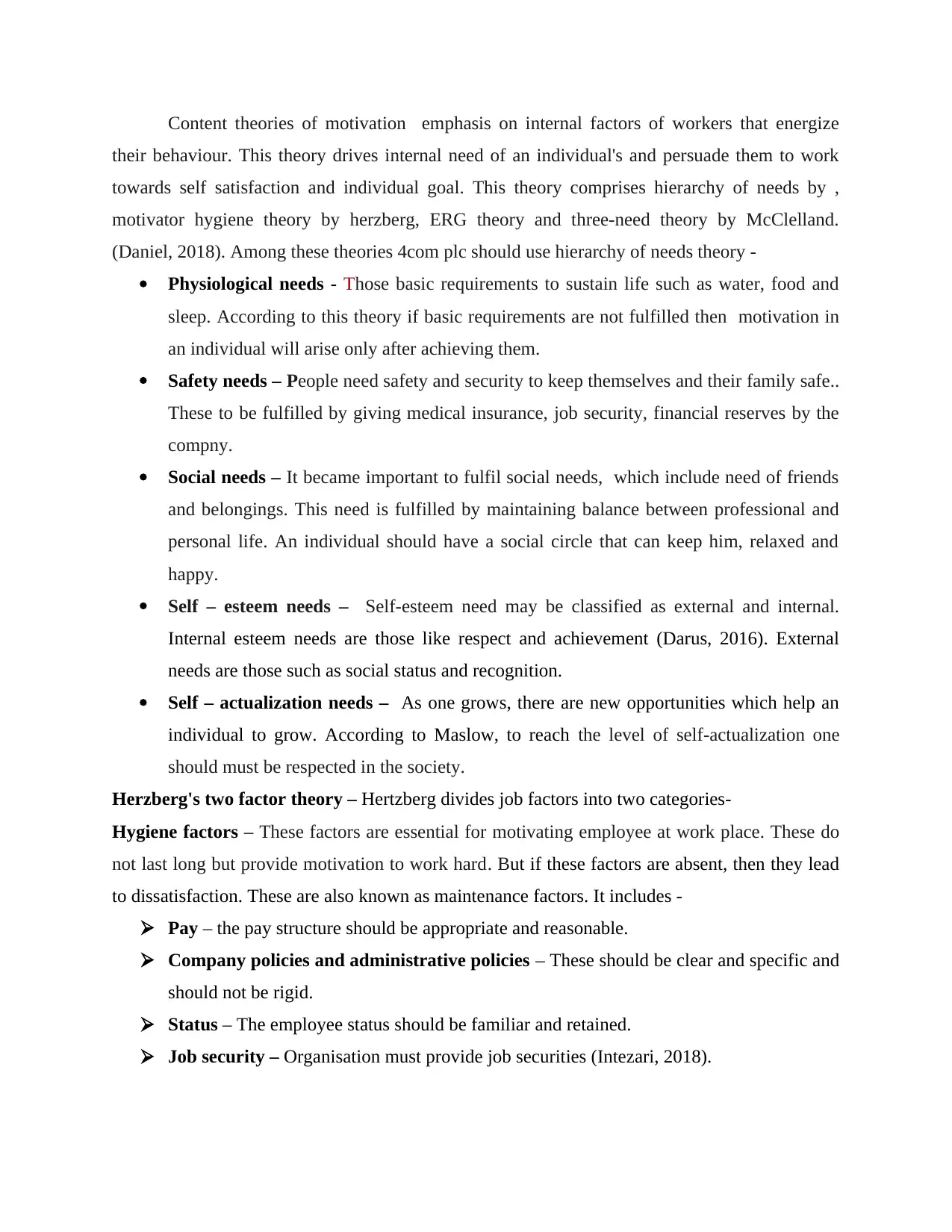
Content theories of motivation emphasis on internal factors of workers that energize
their behaviour. This theory drives internal need of an individual's and persuade them to work
towards self satisfaction and individual goal. This theory comprises hierarchy of needs by ,
motivator hygiene theory by herzberg, ERG theory and three-need theory by McClelland.
(Daniel, 2018). Among these theories 4com plc should use hierarchy of needs theory -
Physiological needs - Those basic requirements to sustain life such as water, food and
sleep. According to this theory if basic requirements are not fulfilled then motivation in
an individual will arise only after achieving them.
Safety needs – People need safety and security to keep themselves and their family safe..
These to be fulfilled by giving medical insurance, job security, financial reserves by the
compny.
Social needs – It became important to fulfil social needs, which include need of friends
and belongings. This need is fulfilled by maintaining balance between professional and
personal life. An individual should have a social circle that can keep him, relaxed and
happy.
Self – esteem needs – Self-esteem need may be classified as external and internal.
Internal esteem needs are those like respect and achievement (Darus, 2016). External
needs are those such as social status and recognition.
Self – actualization needs – As one grows, there are new opportunities which help an
individual to grow. According to Maslow, to reach the level of self-actualization one
should must be respected in the society.
Herzberg's two factor theory – Hertzberg divides job factors into two categories-
Hygiene factors – These factors are essential for motivating employee at work place. These do
not last long but provide motivation to work hard. But if these factors are absent, then they lead
to dissatisfaction. These are also known as maintenance factors. It includes -
Pay – the pay structure should be appropriate and reasonable.
Company policies and administrative policies – These should be clear and specific and
should not be rigid.
Status – The employee status should be familiar and retained.
Job security – Organisation must provide job securities (Intezari, 2018).
their behaviour. This theory drives internal need of an individual's and persuade them to work
towards self satisfaction and individual goal. This theory comprises hierarchy of needs by ,
motivator hygiene theory by herzberg, ERG theory and three-need theory by McClelland.
(Daniel, 2018). Among these theories 4com plc should use hierarchy of needs theory -
Physiological needs - Those basic requirements to sustain life such as water, food and
sleep. According to this theory if basic requirements are not fulfilled then motivation in
an individual will arise only after achieving them.
Safety needs – People need safety and security to keep themselves and their family safe..
These to be fulfilled by giving medical insurance, job security, financial reserves by the
compny.
Social needs – It became important to fulfil social needs, which include need of friends
and belongings. This need is fulfilled by maintaining balance between professional and
personal life. An individual should have a social circle that can keep him, relaxed and
happy.
Self – esteem needs – Self-esteem need may be classified as external and internal.
Internal esteem needs are those like respect and achievement (Darus, 2016). External
needs are those such as social status and recognition.
Self – actualization needs – As one grows, there are new opportunities which help an
individual to grow. According to Maslow, to reach the level of self-actualization one
should must be respected in the society.
Herzberg's two factor theory – Hertzberg divides job factors into two categories-
Hygiene factors – These factors are essential for motivating employee at work place. These do
not last long but provide motivation to work hard. But if these factors are absent, then they lead
to dissatisfaction. These are also known as maintenance factors. It includes -
Pay – the pay structure should be appropriate and reasonable.
Company policies and administrative policies – These should be clear and specific and
should not be rigid.
Status – The employee status should be familiar and retained.
Job security – Organisation must provide job securities (Intezari, 2018).
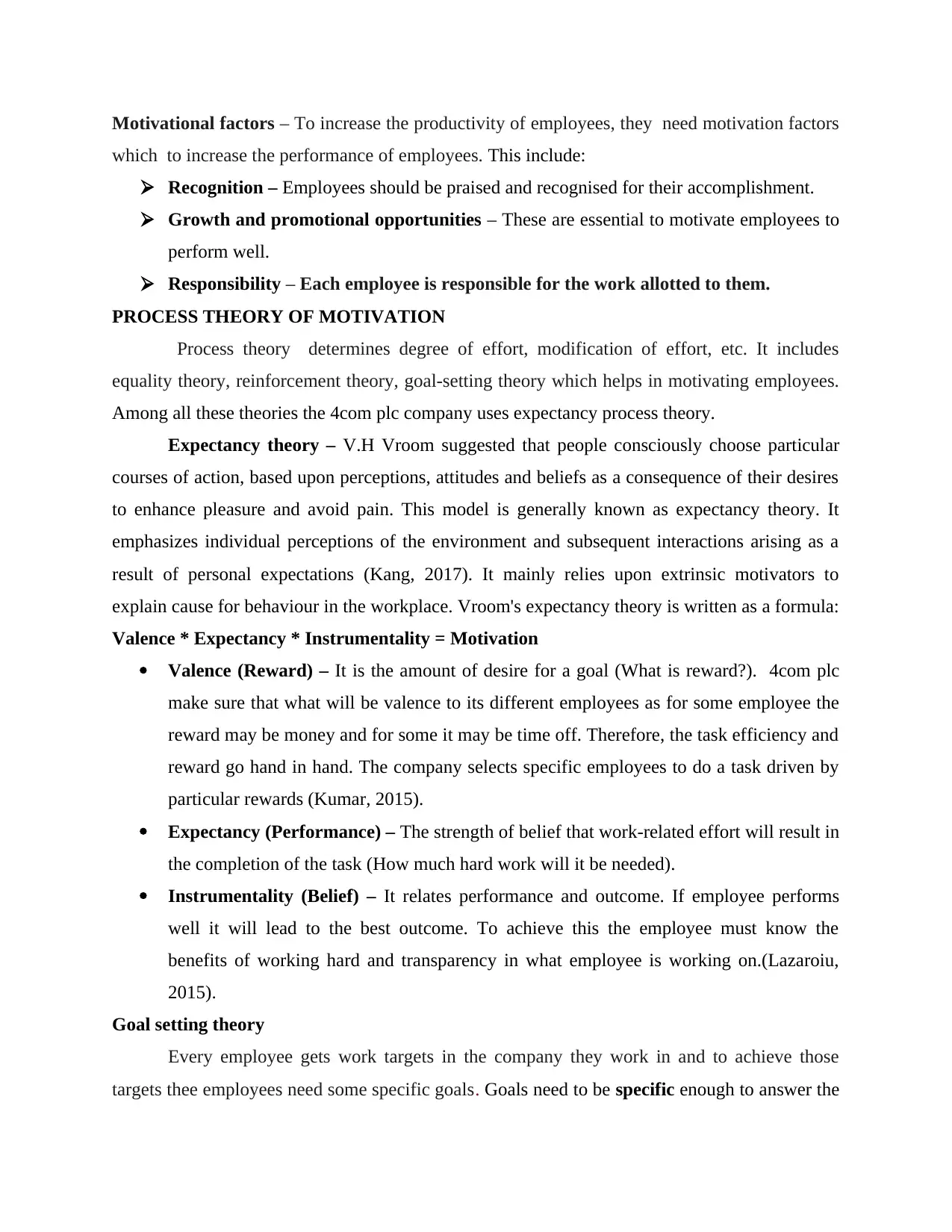
Motivational factors – To increase the productivity of employees, they need motivation factors
which to increase the performance of employees. This include:
Recognition – Employees should be praised and recognised for their accomplishment.
Growth and promotional opportunities – These are essential to motivate employees to
perform well.
Responsibility – Each employee is responsible for the work allotted to them.
PROCESS THEORY OF MOTIVATION
Process theory determines degree of effort, modification of effort, etc. It includes
equality theory, reinforcement theory, goal-setting theory which helps in motivating employees.
Among all these theories the 4com plc company uses expectancy process theory.
Expectancy theory – V.H Vroom suggested that people consciously choose particular
courses of action, based upon perceptions, attitudes and beliefs as a consequence of their desires
to enhance pleasure and avoid pain. This model is generally known as expectancy theory. It
emphasizes individual perceptions of the environment and subsequent interactions arising as a
result of personal expectations (Kang, 2017). It mainly relies upon extrinsic motivators to
explain cause for behaviour in the workplace. Vroom's expectancy theory is written as a formula:
Valence * Expectancy * Instrumentality = Motivation
Valence (Reward) – It is the amount of desire for a goal (What is reward?). 4com plc
make sure that what will be valence to its different employees as for some employee the
reward may be money and for some it may be time off. Therefore, the task efficiency and
reward go hand in hand. The company selects specific employees to do a task driven by
particular rewards (Kumar, 2015).
Expectancy (Performance) – The strength of belief that work-related effort will result in
the completion of the task (How much hard work will it be needed).
Instrumentality (Belief) – It relates performance and outcome. If employee performs
well it will lead to the best outcome. To achieve this the employee must know the
benefits of working hard and transparency in what employee is working on.(Lazaroiu,
2015).
Goal setting theory
Every employee gets work targets in the company they work in and to achieve those
targets thee employees need some specific goals. Goals need to be specific enough to answer the
which to increase the performance of employees. This include:
Recognition – Employees should be praised and recognised for their accomplishment.
Growth and promotional opportunities – These are essential to motivate employees to
perform well.
Responsibility – Each employee is responsible for the work allotted to them.
PROCESS THEORY OF MOTIVATION
Process theory determines degree of effort, modification of effort, etc. It includes
equality theory, reinforcement theory, goal-setting theory which helps in motivating employees.
Among all these theories the 4com plc company uses expectancy process theory.
Expectancy theory – V.H Vroom suggested that people consciously choose particular
courses of action, based upon perceptions, attitudes and beliefs as a consequence of their desires
to enhance pleasure and avoid pain. This model is generally known as expectancy theory. It
emphasizes individual perceptions of the environment and subsequent interactions arising as a
result of personal expectations (Kang, 2017). It mainly relies upon extrinsic motivators to
explain cause for behaviour in the workplace. Vroom's expectancy theory is written as a formula:
Valence * Expectancy * Instrumentality = Motivation
Valence (Reward) – It is the amount of desire for a goal (What is reward?). 4com plc
make sure that what will be valence to its different employees as for some employee the
reward may be money and for some it may be time off. Therefore, the task efficiency and
reward go hand in hand. The company selects specific employees to do a task driven by
particular rewards (Kumar, 2015).
Expectancy (Performance) – The strength of belief that work-related effort will result in
the completion of the task (How much hard work will it be needed).
Instrumentality (Belief) – It relates performance and outcome. If employee performs
well it will lead to the best outcome. To achieve this the employee must know the
benefits of working hard and transparency in what employee is working on.(Lazaroiu,
2015).
Goal setting theory
Every employee gets work targets in the company they work in and to achieve those
targets thee employees need some specific goals. Goals need to be specific enough to answer the
⊘ This is a preview!⊘
Do you want full access?
Subscribe today to unlock all pages.

Trusted by 1+ million students worldwide
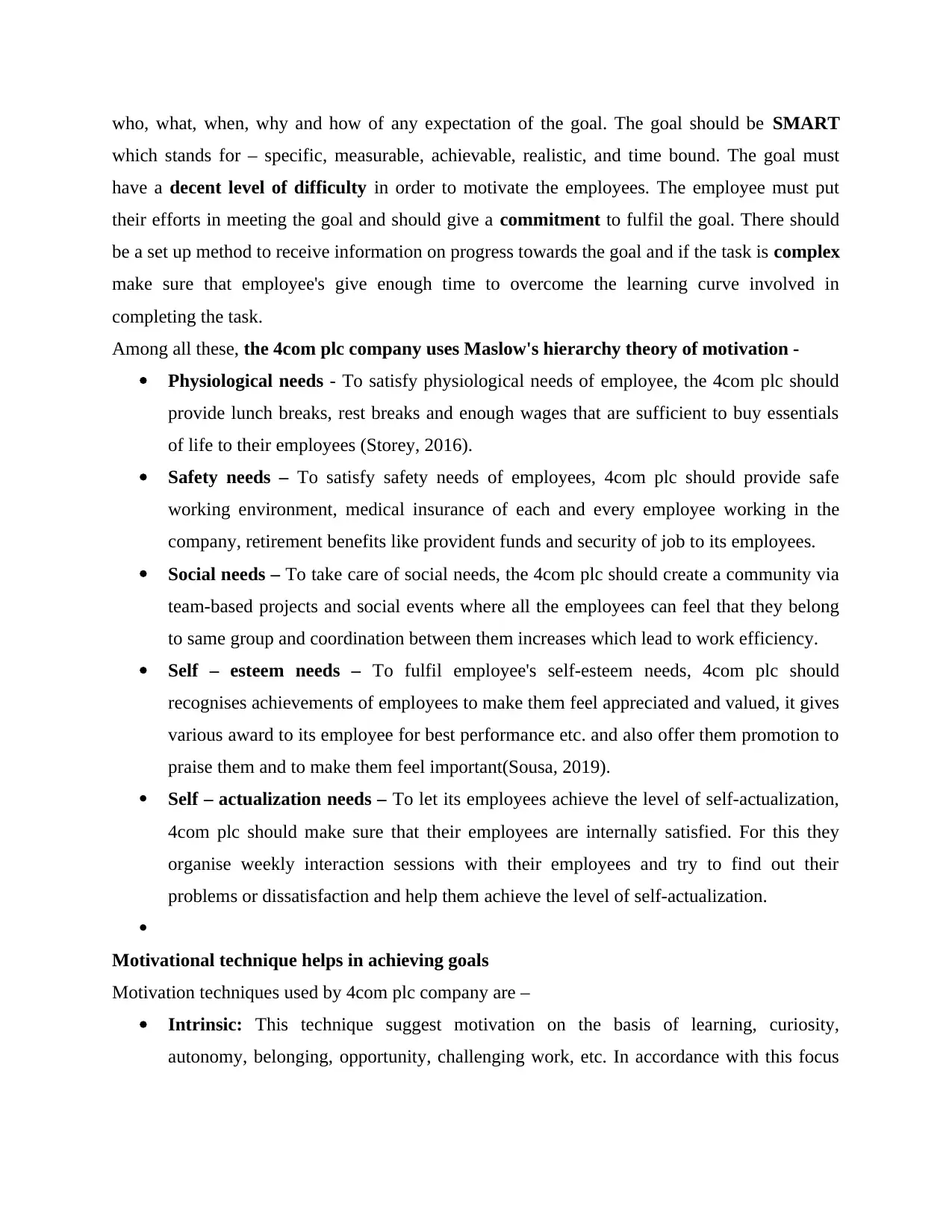
who, what, when, why and how of any expectation of the goal. The goal should be SMART
which stands for – specific, measurable, achievable, realistic, and time bound. The goal must
have a decent level of difficulty in order to motivate the employees. The employee must put
their efforts in meeting the goal and should give a commitment to fulfil the goal. There should
be a set up method to receive information on progress towards the goal and if the task is complex
make sure that employee's give enough time to overcome the learning curve involved in
completing the task.
Among all these, the 4com plc company uses Maslow's hierarchy theory of motivation -
Physiological needs - To satisfy physiological needs of employee, the 4com plc should
provide lunch breaks, rest breaks and enough wages that are sufficient to buy essentials
of life to their employees (Storey, 2016).
Safety needs – To satisfy safety needs of employees, 4com plc should provide safe
working environment, medical insurance of each and every employee working in the
company, retirement benefits like provident funds and security of job to its employees.
Social needs – To take care of social needs, the 4com plc should create a community via
team-based projects and social events where all the employees can feel that they belong
to same group and coordination between them increases which lead to work efficiency.
Self – esteem needs – To fulfil employee's self-esteem needs, 4com plc should
recognises achievements of employees to make them feel appreciated and valued, it gives
various award to its employee for best performance etc. and also offer them promotion to
praise them and to make them feel important(Sousa, 2019).
Self – actualization needs – To let its employees achieve the level of self-actualization,
4com plc should make sure that their employees are internally satisfied. For this they
organise weekly interaction sessions with their employees and try to find out their
problems or dissatisfaction and help them achieve the level of self-actualization.
Motivational technique helps in achieving goals
Motivation techniques used by 4com plc company are –
Intrinsic: This technique suggest motivation on the basis of learning, curiosity,
autonomy, belonging, opportunity, challenging work, etc. In accordance with this focus
which stands for – specific, measurable, achievable, realistic, and time bound. The goal must
have a decent level of difficulty in order to motivate the employees. The employee must put
their efforts in meeting the goal and should give a commitment to fulfil the goal. There should
be a set up method to receive information on progress towards the goal and if the task is complex
make sure that employee's give enough time to overcome the learning curve involved in
completing the task.
Among all these, the 4com plc company uses Maslow's hierarchy theory of motivation -
Physiological needs - To satisfy physiological needs of employee, the 4com plc should
provide lunch breaks, rest breaks and enough wages that are sufficient to buy essentials
of life to their employees (Storey, 2016).
Safety needs – To satisfy safety needs of employees, 4com plc should provide safe
working environment, medical insurance of each and every employee working in the
company, retirement benefits like provident funds and security of job to its employees.
Social needs – To take care of social needs, the 4com plc should create a community via
team-based projects and social events where all the employees can feel that they belong
to same group and coordination between them increases which lead to work efficiency.
Self – esteem needs – To fulfil employee's self-esteem needs, 4com plc should
recognises achievements of employees to make them feel appreciated and valued, it gives
various award to its employee for best performance etc. and also offer them promotion to
praise them and to make them feel important(Sousa, 2019).
Self – actualization needs – To let its employees achieve the level of self-actualization,
4com plc should make sure that their employees are internally satisfied. For this they
organise weekly interaction sessions with their employees and try to find out their
problems or dissatisfaction and help them achieve the level of self-actualization.
Motivational technique helps in achieving goals
Motivation techniques used by 4com plc company are –
Intrinsic: This technique suggest motivation on the basis of learning, curiosity,
autonomy, belonging, opportunity, challenging work, etc. In accordance with this focus
Paraphrase This Document
Need a fresh take? Get an instant paraphrase of this document with our AI Paraphraser
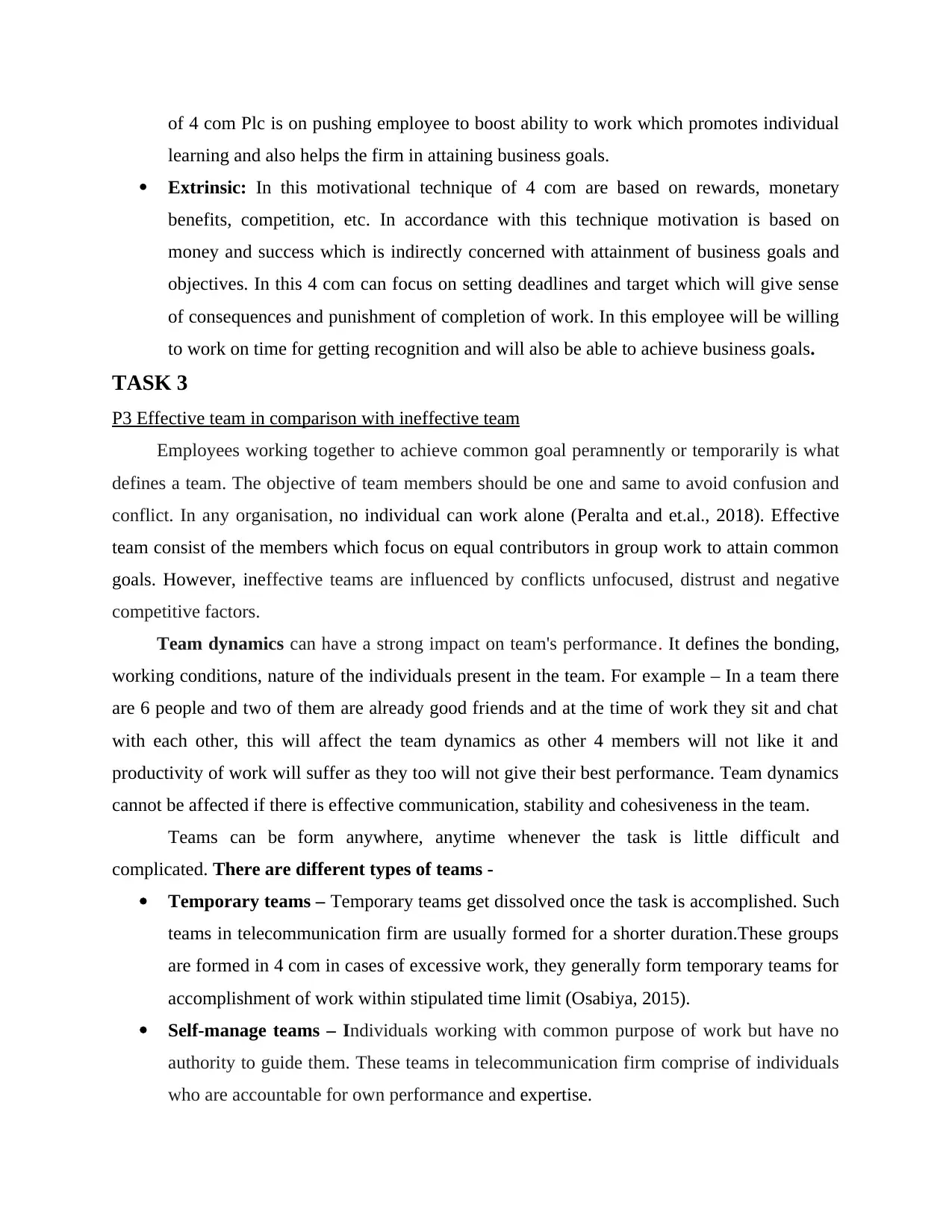
of 4 com Plc is on pushing employee to boost ability to work which promotes individual
learning and also helps the firm in attaining business goals.
Extrinsic: In this motivational technique of 4 com are based on rewards, monetary
benefits, competition, etc. In accordance with this technique motivation is based on
money and success which is indirectly concerned with attainment of business goals and
objectives. In this 4 com can focus on setting deadlines and target which will give sense
of consequences and punishment of completion of work. In this employee will be willing
to work on time for getting recognition and will also be able to achieve business goals.
TASK 3
P3 Effective team in comparison with ineffective team
Employees working together to achieve common goal peramnently or temporarily is what
defines a team. The objective of team members should be one and same to avoid confusion and
conflict. In any organisation, no individual can work alone (Peralta and et.al., 2018). Effective
team consist of the members which focus on equal contributors in group work to attain common
goals. However, ineffective teams are influenced by conflicts unfocused, distrust and negative
competitive factors.
Team dynamics can have a strong impact on team's performance. It defines the bonding,
working conditions, nature of the individuals present in the team. For example – In a team there
are 6 people and two of them are already good friends and at the time of work they sit and chat
with each other, this will affect the team dynamics as other 4 members will not like it and
productivity of work will suffer as they too will not give their best performance. Team dynamics
cannot be affected if there is effective communication, stability and cohesiveness in the team.
Teams can be form anywhere, anytime whenever the task is little difficult and
complicated. There are different types of teams -
Temporary teams – Temporary teams get dissolved once the task is accomplished. Such
teams in telecommunication firm are usually formed for a shorter duration.These groups
are formed in 4 com in cases of excessive work, they generally form temporary teams for
accomplishment of work within stipulated time limit (Osabiya, 2015).
Self-manage teams – Individuals working with common purpose of work but have no
authority to guide them. These teams in telecommunication firm comprise of individuals
who are accountable for own performance and expertise.
learning and also helps the firm in attaining business goals.
Extrinsic: In this motivational technique of 4 com are based on rewards, monetary
benefits, competition, etc. In accordance with this technique motivation is based on
money and success which is indirectly concerned with attainment of business goals and
objectives. In this 4 com can focus on setting deadlines and target which will give sense
of consequences and punishment of completion of work. In this employee will be willing
to work on time for getting recognition and will also be able to achieve business goals.
TASK 3
P3 Effective team in comparison with ineffective team
Employees working together to achieve common goal peramnently or temporarily is what
defines a team. The objective of team members should be one and same to avoid confusion and
conflict. In any organisation, no individual can work alone (Peralta and et.al., 2018). Effective
team consist of the members which focus on equal contributors in group work to attain common
goals. However, ineffective teams are influenced by conflicts unfocused, distrust and negative
competitive factors.
Team dynamics can have a strong impact on team's performance. It defines the bonding,
working conditions, nature of the individuals present in the team. For example – In a team there
are 6 people and two of them are already good friends and at the time of work they sit and chat
with each other, this will affect the team dynamics as other 4 members will not like it and
productivity of work will suffer as they too will not give their best performance. Team dynamics
cannot be affected if there is effective communication, stability and cohesiveness in the team.
Teams can be form anywhere, anytime whenever the task is little difficult and
complicated. There are different types of teams -
Temporary teams – Temporary teams get dissolved once the task is accomplished. Such
teams in telecommunication firm are usually formed for a shorter duration.These groups
are formed in 4 com in cases of excessive work, they generally form temporary teams for
accomplishment of work within stipulated time limit (Osabiya, 2015).
Self-manage teams – Individuals working with common purpose of work but have no
authority to guide them. These teams in telecommunication firm comprise of individuals
who are accountable for own performance and expertise.
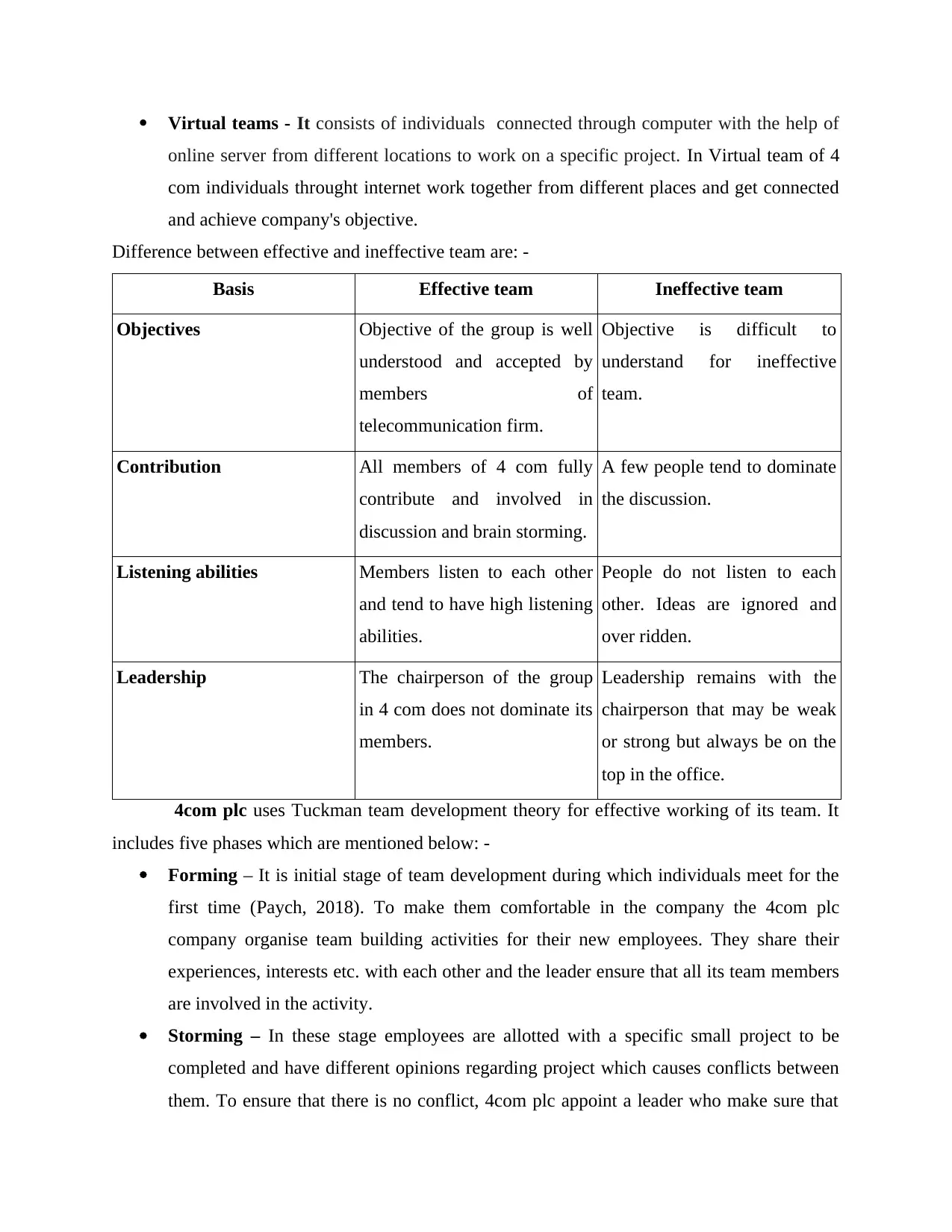
Virtual teams - It consists of individuals connected through computer with the help of
online server from different locations to work on a specific project. In Virtual team of 4
com individuals throught internet work together from different places and get connected
and achieve company's objective.
Difference between effective and ineffective team are: -
Basis Effective team Ineffective team
Objectives Objective of the group is well
understood and accepted by
members of
telecommunication firm.
Objective is difficult to
understand for ineffective
team.
Contribution All members of 4 com fully
contribute and involved in
discussion and brain storming.
A few people tend to dominate
the discussion.
Listening abilities Members listen to each other
and tend to have high listening
abilities.
People do not listen to each
other. Ideas are ignored and
over ridden.
Leadership The chairperson of the group
in 4 com does not dominate its
members.
Leadership remains with the
chairperson that may be weak
or strong but always be on the
top in the office.
4com plc uses Tuckman team development theory for effective working of its team. It
includes five phases which are mentioned below: -
Forming – It is initial stage of team development during which individuals meet for the
first time (Paych, 2018). To make them comfortable in the company the 4com plc
company organise team building activities for their new employees. They share their
experiences, interests etc. with each other and the leader ensure that all its team members
are involved in the activity.
Storming – In these stage employees are allotted with a specific small project to be
completed and have different opinions regarding project which causes conflicts between
them. To ensure that there is no conflict, 4com plc appoint a leader who make sure that
online server from different locations to work on a specific project. In Virtual team of 4
com individuals throught internet work together from different places and get connected
and achieve company's objective.
Difference between effective and ineffective team are: -
Basis Effective team Ineffective team
Objectives Objective of the group is well
understood and accepted by
members of
telecommunication firm.
Objective is difficult to
understand for ineffective
team.
Contribution All members of 4 com fully
contribute and involved in
discussion and brain storming.
A few people tend to dominate
the discussion.
Listening abilities Members listen to each other
and tend to have high listening
abilities.
People do not listen to each
other. Ideas are ignored and
over ridden.
Leadership The chairperson of the group
in 4 com does not dominate its
members.
Leadership remains with the
chairperson that may be weak
or strong but always be on the
top in the office.
4com plc uses Tuckman team development theory for effective working of its team. It
includes five phases which are mentioned below: -
Forming – It is initial stage of team development during which individuals meet for the
first time (Paych, 2018). To make them comfortable in the company the 4com plc
company organise team building activities for their new employees. They share their
experiences, interests etc. with each other and the leader ensure that all its team members
are involved in the activity.
Storming – In these stage employees are allotted with a specific small project to be
completed and have different opinions regarding project which causes conflicts between
them. To ensure that there is no conflict, 4com plc appoint a leader who make sure that
⊘ This is a preview!⊘
Do you want full access?
Subscribe today to unlock all pages.

Trusted by 1+ million students worldwide
1 out of 17
Related Documents
Your All-in-One AI-Powered Toolkit for Academic Success.
+13062052269
info@desklib.com
Available 24*7 on WhatsApp / Email
![[object Object]](/_next/static/media/star-bottom.7253800d.svg)
Unlock your academic potential
Copyright © 2020–2025 A2Z Services. All Rights Reserved. Developed and managed by ZUCOL.




